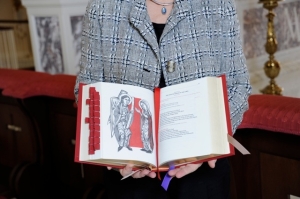
Father Richard Hilgartner talks about the new Roman Missal during a June 23 workshop at the Catholic Media Convention in Pittsburgh. (CR/George P. Matysek Jr.)
PITTSBURGH – You might call it liturgical autopilot.
As soon as Catholics hear a priest say, “The Lord be with you,” they instinctively respond, “And also with you.”
That’s all about to change Nov. 27 when the English-speaking world begins using the new Roman Missal – the book of liturgical prayers that has been more literally and poetically translated from the Latin.
With the new translation, English-speaking Catholics will now respond to the priest or deacon with, “And with your spirit.”
Father Richard Hilgartner, a Baltimore priest who serves as director of the U.S. Bishops’ Secretariat for Divine Worship, acknowledged that the change will probably be one of the more challenging ones for Catholics to accept. “And also with you” has been used for more than four decades. It’s the only response many Catholics have ever known.
During a June 23 workshop on the new Roman Missal, given at the Catholic Media Convention in Pittsburgh, Father Hilgartner delved into some of the reasons why “And with your spirit” has been adopted.
The phrase has ancient roots in Scripture. It was used in the Book of Ruth and the Book of Chronicles. The angel Gabriel greeted the Blessed Virgin Mary with those words, the priest noted, and St. Paul often signed off his letters that way.
Father Hilgartner pointed out that there’s also an important functional component to the words.
The Latin is, “Dominus vobiscum et cum spiritu tuo.” It contains no verb. It’s as much a statement of fact as it is a greeting, Father Hilgartner said.
“‘The Lord be with you,’ is saying that the Lord is present in this gathering,” the priest explained. “The people’s response back to the priest – ‘and with your spirit’ – is an acknowledgment that the priest’s spirit has been configured and conformed to Christ by virtue of ordination to act as Christ presiding over the assembly.”
When the priest says, ‘The Lord be with you,’ the people’s response is not some kind of “right back at you Father!” as much as it is focused on allowing Christ to work through that priest, Father Hilgartner said.
“It’s a reminder to the priest that what he does, he does because the Church has called him and ordained him to act in the person of Christ,” he said. “The priest acknowledges the presence of Christ in the assembly and the assembly acknowledges the presence of Christ working in and through the priest.”
The liturgical act can take place, Father Hilgartner explained, “because the Church is rightly gathered and rightly ordered.”
“It’s a statement of ecclesiology,” he said.
Father Hilgartner noted that English-speaking countries are in the minority by not having a literal translation of the Latin for the dialogue, which is used at the beginning of Mass, at the proclamation of the Gospel by a priest or deacon, at the beginning of the eucharistic prayer and at the final blessing at Mass. The Italian translation is “E con il tuo spirito,” French: “Et avec votre esprit,” Spanish: “Y con tu espíritu,” and German: “Und mit deinem Geiste.”
It will take some time before people adjust to the change. But, if parishes do a good job explaining the reasons behind that and other changes, it will be a great moment of catechesis when we can all learn more about what we really believe as Catholics.
In the coming weeks, The Catholic Review will feature an in-depth look at Father Hilgartner’s ministry at the bishops’ conference.





